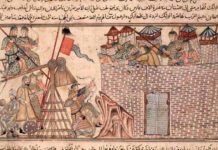Chiang Mai has been around for seven hundred years, serving as a hub for trade, politics, and the rich culture of northern Thailand. Here’s to the next seven hundred.
Here, it’s easy to believe you could open any door and step deep into the past. Perhaps it’s way the scent of plumeria sweeps past you as you walk, or the flash of the city’s three hundred temples as they stretch golden spires into the tropical sky. This place has magic about it. Chiang Mai is, of course, a modern city; it zooms with scooters and coffee-shops. Still, the centuries that have shaped the landscape of today’s Chiang Mai have carved themselves deeply, and its past is as intriguing as its future.
Early Chiang Mai History
There’s no doubt that Chiang Mai is the grand dame of the region, squared neatly off by a moat and set like a jewel on the banks of the Mae Nam Ping. The city boasts a 700-year history, mostly due to its terrific location. Chiang Mai grew from its early hamlethood to become a major stop on an ancient trade route. After all, the city happened to be poised perfectly between the Chinese Yunnan goods centers and the bustling Burmese ports that moved mercantile ships through India. As a result, Chiang Mai thrived. Long before the first tourist shuffled in, the city served as the nation’s major source of fabrics, silver, handicrafts, woodwork and the like, as well as feeding and housing the constant flow of merchants that came through.
After serving for many decades as a bustling river port, the city was ready for its political closeup. King Mengrai, leader of the Lanna Kingdom (the precursor to what we know now as the country of Thailand), appointed Chiang Mai as capitol in 1296. To protect the new city against troublesome raiders from Burma, Mengrai constructed a moat and a stone wall around the city. (The walls have, for the most part, fallen; however, the moat remains a feature of deep cultural significance to Chiang Mai residents, featuring prominently in the beloved water-splashing festival of Songkran.)
Burmese Raiders
The walls couldn’t hold off the Burmese, unfortunately. After a series of heinous attacks the Lanna kingdom eventually declined, temporarily reducing the city’s importance and opening it up to an exhausting series of occupiers. The troubles culminated in the spring of 1766, when brutal Burmese wars forced the few remaining inhabitants of the city to flee with little more than the shirts on their backs. Even though the city became an official part of the kingdom of Siam in 1774 (when King Taksin captured it from the Burmese), most of the population didn’t filter back in until the very late 1700’s.
With the return of its population, Chiang Mai clambered back on her feet. Over the next few decades, the city steadily regained its cultural, economic, and political significance. Of course, once the beautiful city was dusted off and rebuilt, colonial interest was bound to follow. British teak concerns based in nearby Burma began to pursue governmental partnerships in the northern provinces of Thailand, Chiang Mai included.
Colonial Chiang Mai
Because the river upon which Chiang Mai sits is extremely difficult to navigate, the southern government didn’t often make it upriver to oversee the local ruler, a regional prince. Unfortunately, the prince became a bit greedy when the region’s colonists started to show up, look around, and pull out checkbooks. As a result, nasty conflicts flared up when the prince granted land leases and teak concessions to more than one interested company – for the same parcels. The resulting fracas (as well as the incursion of French and missionary interests in the northern provinces) finally forced the Bangkok Government to make the trip upriver. Bangkok took firm administrative control of Chiang Mai (and the rest of the north, piece by piece) in the 1890’s. When the last local hereditary ruler died in 1939, the Bangkok-based government assumed total power over the northern provinces, Chiang Mai included. The Thailand we know now was born.
The Modern City
Today, Chiang Mai is the capitol of its own province. The second-largest city in Thailand after her southern sister Bangkok, Chiang Mai is the northern socioeconomic hub of the country. (For visitors, this means that Chiang Mai’s hundreds of guesthouses often serve as a base for exploration of the northern provinces, Myanmar, and Laos.) The proverbial ‘pot’ of northern Thailand has melted into the city’s diverse populace, a buzzing university community with members of all the surrounding ethnic groups (including hill tribes, Hindus, and Muslims) represented. The current King and Queen have a palace here, perched high on a closely neighboring mountain.
Even though Chiang Mai bubbles with tourists, it hasn’t acquired the cheap soigné varnish that other cities in southeast Asia have painted on themselves. This writer would like to think that it’s because it sits firmly in the wisdom of its advanced age. Regardless, the old magic of this city feeds and encourages its moments of ebullient newness, giving a delightful resonance to even its most everyday moments. Tuck a plumeria blossom behind your ear, and you’ll feel it too.








